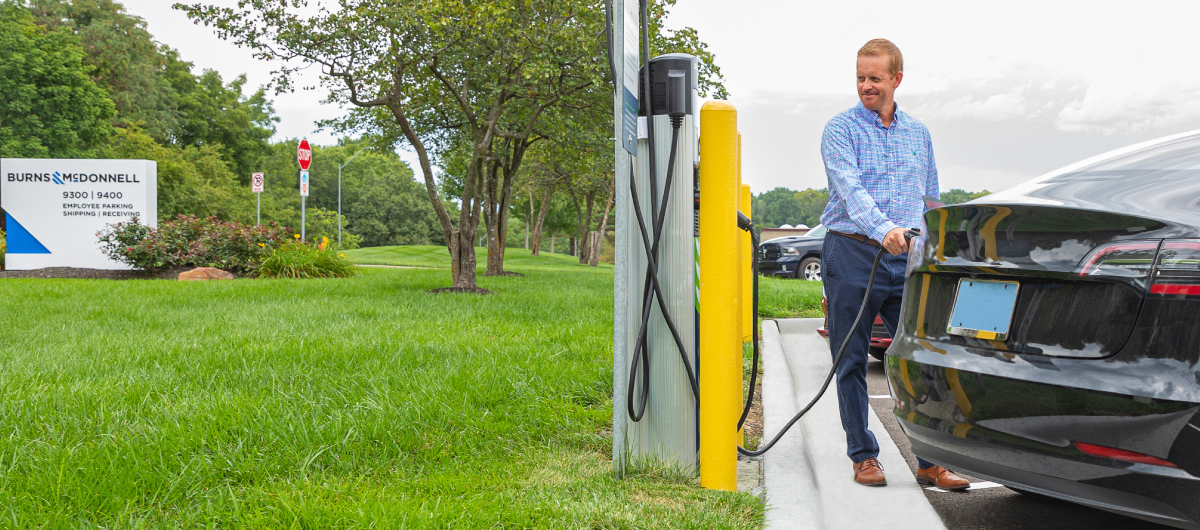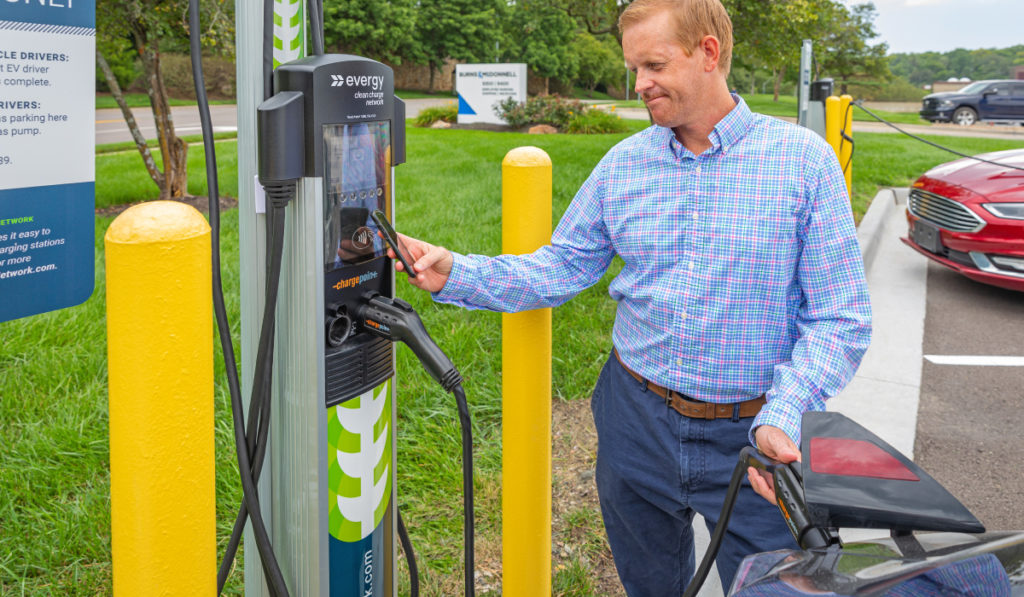
HOST PROFILE
|September 2020 NEWSLETTER
Burns & McDonnell
Named one of the 100 Best Companies to work for ten years in a row by Fortune magazine, Burns & McDonnell is known for its employee ownership culture and industry-leading incentives. The full-service engineering company is no stranger to environmental and electrification projects, so when the opportunity to add electric vehicle charging stations to their list of benefits came along, it was a perfect fit.
As self-described “tinkerers by nature” and adopters of technology, the employee-owners of Burns & McDonnell like to walk the walk, holding regular “lunch and learns” on topics they are interested in both personally and professionally, such as electrification and decarbonization.
Read on for our interview with Travis Bouslog, Project Manager at 1898 & Co. (part of the Burns & McDonnell Family of Companies) and Dave Grosdeck, Property Manager at Burns & McDonnell, as they recount how charging stations came to be a workplace perk:
How did your commitment to electric vehicle charging begin?
Nearly a decade ago, Burns & McDonnell kicked off an initiative at our world headquarters in Kansas City, called, “Blue goes Green,” as part of our continued sustainability efforts. There was an interest to install electric vehicle charging stations in our parking lot for employee-owners. To learn more, we hosted demonstrations on campus from a variety of companies. In 2012, we installed our first charging station. With growing interest in electric and plug-in hybrid vehicles, we installed more in 2014.
How did your efforts to offer electric vehicle charging progress?
Burns & McDonnell is comprised of everything from engineers to scientists. Our employee-owners are curious, forward-thinking and are obsessed with innovation. They want to try out new technology to not only experience for ourselves, but also our clients
In 2015, we began working with Evergy’s Clean Charge Network to provide more charging stations for our employee-owners and the public. As we expanded our campus, we installed additional charging stations and soon upgraded to smart chargers that provide more data that can let you know when they are fully charged.
Today, Burns & McDonnell has two public charging stations in their surface lot and six stations in parking garages for employee-owner use, as well as additional dedicated stations for their fleet and courier vehicles.
Why did you want to offer EV charging?
We are strong believers in sustainability and want to provide our employee-owners – and the public – with options that support such initiatives.
Plus, the demand for EVs is rapidly growing. Bloomberg New Energy Finance predicts 31% of all vehicles on the road will be 100-percent electric by 2040. We have definitely seen the demand for EVs grow over the years among our employee-owners.

“Having workplace charging has been such a benefit to me. I charge both at home and my work at Burns & McDonnell and being able to charge at the office once or twice per week really helps. Having workplace charging really made transitioning to EV very easy”.
Adam Young, Director
1898 & Co., part of Burns & McDonnell
How have you seen electric transportation grow?
The growth of electric vehicles in our area is staggering. For example, on the Burns & Mac campus alone, the number of hybrid and electric cars is on par with the state of California – when you look at the number of those registered per 1000 vehicles.
Burns & McDonnell and 1898 & Co. are involved in a fast-growing number of electrification projects throughout the country. And we offer a wide range of services in this space from consulting on EV initiatives to building the grid that supports electrifications efforts.
In 2018, Burns & McDonnell announced it was selected to develop an electrification road map for Foothill Transit in Southern California, allowing the environmentally friendly transit agency to convert to a 100 percent electric bus fleet by 2030. The electrification road map will provide a conceptual plan to incrementally build out the infrastructure needed at the depots to support an electrified fleet.
What do you want to say to EV drivers?
The number of electric vehicles on U.S. roads is expected to increase dramatically in the next 5 to 20 years. To prepare for this growth, utilities are learning the full effect EV charging will have on long-term peak demand.
Thanks to everything from LED lighting to better insulation, we live in a world that is growing more energy efficient by the day. With residential and industrial users consuming less and self-producing more energy than they once did, utilities are left with excess capacity on the grid.
These investments in making the grid smarter, more efficient, and more dependent on power from wind, solar, and other distributed energy resources (DERs) give consumers the ability to support electrification. EV drivers will play a key role in building out the infrastructure needed for large-scale adoption.
